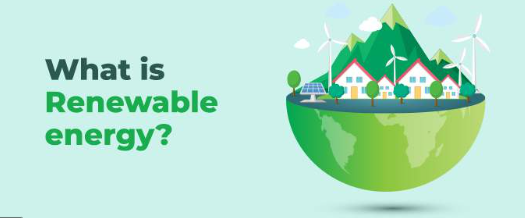What is Renewable Energy? – Definition, Types and Benefits
What do You Mean by Renewable Energy?
Renewable energy is energy stored from renewable resources that are naturally replenished on a human time scale. Think of sources such as sunlight, wind, water (rain, tide, waves), and geothermal heat. While most renewables are sustainable, some are not. Like, some biomass sources are unsustainable at different exploitation rates. Renewable energy sources typically provide energy for grid electricity generation, air and water heating/cooling, and independent energy systems. About 20% of global human energy consumption comes from renewable energy sources, including about 30% of electricity.

The production of renewable energy produces fewer emissions than the combustion of fossil fuels. Switching from fossil fuels, which currently cause the most emissions, to renewable fuels is critical to solving the climate crisis. Renewable energy is now cheaper in most countries and creates three times more jobs than fossil fuels.
SOURCES OF RENEWABLE ENERGY
SOLAR ENERGY
Solar energy is the most common energy source and can be used even in cloudy weather. The level of solar energy intercepted by the earth is approximately 10,000 times higher than the rate of human energy consumption.
Solar technology can provide heat, cooling, natural light, electricity and fuel for many applications. Solar technology converts sunlight into electricity, both through photovoltaic panels and through glasses that concentrate solar radiation.
While not all countries have the same amount of solar energy, each country can make a significant contribution to the direct solar energy mix.
The cost of producing solar panels has dropped dramatically in recent decades, making them not only affordable but often the cheapest form of electricity. Solar panels have a lifespan of around 30 years and are available in a variety of colors depending on the type of material used in their production.
WIND ENERGY
Wind power uses the kinetic energy of air moving through large wind turbines on land, sea or freshwater (offshore), but more recently, onshore and offshore wind technologies have been developed. , the higher the turbines, the larger the rotor diameter
Although average wind speeds vary widely by location, the global technical capacity for wind energy exceeds global electricity generation and there is ample potential to deploy wind energy in many regions of the world.
Wind speeds are strong in many parts of the world, but the best locations for generating wind power are sometimes remote. Offshore wind energy offers great potential.
GEOTHERMAL ENERGY
Geothermal energy uses energy from the earth. Heat is extracted from geothermal pools by springs or other methods.
Reservoirs that are warm enough and naturally permeable are called hydrothermal reservoirs, while reservoirs that are warm enough but enhanced by hydraulic stimulation are called enhanced geothermal systems.
After reaching the surface, liquids of different temperatures can be used to generate electricity. The technology to generate electricity from hydrothermal reservoirs is mature and reliable and has been used for over 100 years.
HYDROPOWER
Hydroelectric power uses water energy to transfer energy from upstream to downstream. It can be made from reservoirs and rivers. Hydroelectric plants depend on water stored in reservoirs, while hydroelectric plants get their energy from the power of rivers.
Hydropower has many uses in storage: drinking water, water for irrigation, flood and drought management, shipping, and energy supply.
Hydropower is currently the main source of renewable energy in the electricity sector. It often depends on irrigation practices and drought can negatively impact irrigation practices as climate or environmental changes affect them.
The infrastructure required for hydropower generation can have a negative impact on the environment. For this reason, many people consider small hydropower to be a more environmentally friendly option, especially in communities living in remote areas.
OCEAN ENERGY
Ocean power comes from the technology that uses the kinetic and thermal energy of ocean water — such as waves or tides — to generate electricity or heat.
The marine energy system is still under development, with several prototype instruments to measure currents and currents. The theoretical energy potential of the ocean easily exceeds current energy needs.
BIOENERGY
Bioenergy is produced from various types of organic matter called biomass. Like wood, coal, and manure to generate heat and electricity, and biofuels and water from crops. Biomass is mostly used for cooking, lighting, and heating in rural areas, especially for the poor in developing countries.
Current biomass systems include crops and timber, agricultural and forestry residues, and various organic waste streams.
Energy from biomass combustion releases greenhouse gases, but not as much as burning fossil fuels such as coal, oil, and gas. However, due to the negative environmental impacts associated with the expansion of forests and gardens, and consequent deforestation and land use change, biomass has to be used in limited applications.
Make renewable energy technology a global public good
To ensure that renewable energy technologies are a global public good – a common definition, not just for the wealthy – it is important to remove barriers to knowledge sharing and technology transfer, including intellectual property rights. There are also limits.
Core technologies such as battery storage facilities can store and release energy from renewable sources such as solar and wind power when people, communities, and businesses need power. International Renewable Energy Agency, absorb, store, recharge, and help increase the resilience of energy systems through their unique ability to do so.
In addition, battery storage technology, when combined with renewable grids, can provide more reliable and cost-effective electricity to isolated grids and communities in remote areas.
Renewable Energy and You
Installing or implementing renewable energy in your home can accelerate the transition to clean energy in the future. Even if you can’t install solar panels, you can opt for solar power. (Check with your utility company to find out if this option is available.) If your facility does not have renewable energy, you can purchase renewable energy certificates to reduce your usage.